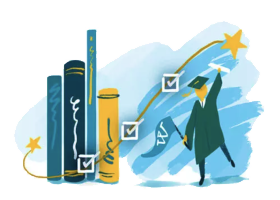For many primary and secondary schools across the nation, being selected as a National Blue Ribbon School is the ultimate dream. Hundreds are picked each year through this U.S. Department of Education program, like the 362 schools that received the distinction in 2019. The awardees include public, private, urban, rural, traditional, magnet, charter, Title I, elementary, middle, and high schools.1 Although they may not look the same, all of the schools had to meet rigorous criteria to even be nominated.
Demographic Diversity
To start with, at least one-third of the public schools nominated by each state should serve a significant number of disadvantaged students. The Department of Education has set this number at 40% of the total school population in most cases. “Disadvantaged” can reflect a number of challenges affecting a student’s life, including economic hardships, physical or learning disabilities, being an English language learner, and coming from a migrant family.
As much as possible, these institutions should also reflect the demographic and geographic diversity of all of the state’s public schools.
Exemplary Performance or Improvement
A National Blue Ribbon School nominee must also meet certain academic benchmarks—as a whole school and as its various student subgroups (categorized by gender, race or ethnicity, socioeconomic status, disability, language, or other designation). Eligible schools can be nominated in one of two categories: Exemplary High Performing Schools and Exemplary Achievement Gap Closing Schools. The first category shows that a school and its subgroups have met the state’s assessment performance criteria in mathematics and reading or English language arts. Additionally, a high school’s graduation rate must rank in the top 15% in the state. The second award category shows that a school and its subgroups performed better on state assessments during the most recent academic year compared with the previous two to four years.2
While awards criteria address how students perform, they don’t reflect learning styles or types of activities used to engage students. In National Blue Ribbon Schools, learning often moves beyond mere recitation of facts and emphasizes creativity and hands-on experiences. For example, at one school, instead of just reading a biology textbook and working abstract math problems, students master concepts by working with farm animals and calculating the cost of planting crops in the campus greenhouse.3
Exceptional Leadership
Effective leadership is essential to a school’s success and to raising the bar on student achievement. School principals are at the forefront of these efforts. Duties of a principal include hiring teachers and staff, monitoring school assessment data, and working to ensure educational goals are met.4 Although leadership styles will vary, principals must strive to create and maintain a safe and positive school culture. Such a learning environment is necessary for students to perform at their best.
Becoming a principal involves first knowing how to teach. Universities typically require candidates to have a teaching license and at least one year of teaching experience before admitting them into a principal preparation program. While a master’s degree is enough for some, many candidates opt for the more advanced Education Specialist (EdS) degree. More and more of these candidates are working professionals looking to earn their Education Specialist degree online, and Walden University offers online education programs that allow students to earn an advanced degree on a schedule that works for them.
Walden University is an accredited institution offering an EdS in Educational Leadership and Administration (Principal Licensure Preparation) degree program online. Expand your career options and earn your degree using a convenient, flexible learning platform that fits your busy life.
1Source: https://www2.ed.gov/programs/nclbbrs/awards.html
2Source: https://www2.ed.gov/programs/nclbbrs/eligibility.html
3Source: https://blog.ed.gov/2019/09/national-blue-ribbon-schools-learning-creative-contexts/
4Source: https://www.waldenu.edu/education-specialist/eds-in-educational-leadership-and-administration/resource/what-are-the-duties-of-a-school-principal
Walden University is accredited by The Higher Learning Commission, www.hlcommission.org.




